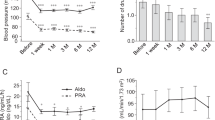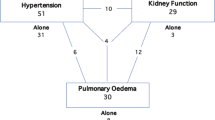Abstract
Fibromuscular dysplasia (FMD) mainly affects renal arteries. Percutaneous transluminal renal angioplasty (PTRA) and surgery are effective treatments, but long-time follow-up is lacking. Retrospective follow-up for 7.0±4.7 years of 69 consecutive patients (age 44±13 years) treated for hypertension due to FMD, 59 patients underwent PTRA and eight patients surgery. In two patients no PTRA was performed. Technical success was achieved in 56 (95%) patients undergoing PTRA and all eight undergoing surgery. After successful PTRA, both systolic and diastolic blood pressures (SBP and DBP) had decreased at discharge (from 174±33/100±13 to 138±19/80±15 mmHg; P<0.0001), and remained lower at 1 month, 1 year, and last follow-up after 7.0±4.7 years (140±25/83±12 mmHg; P<0.0001). Serum-creatinine had decreased both at 1 year (from 84±28 to 75±13 μmol/l; P=0.0030) and last follow-up (75±16 μmol/l; P=0.0017). The number of antihypertensive drugs decreased (from 2.3±1.2 before PTRA to 1.4±1.3 at discharge and at 1 month; P<0.0001, and 1.6±1.5 at last follow-up; P=0.0011). SBP decreased more after PTRA among patients with FMD only in the main renal artery than in those with branch artery involvement (43±29 vs 20±41 mmHg; P=0.0198). Beneficial effects on BP, creatinine and antihypertensive drugs also occurred after surgery. Patients on antihypertensive drugs at last follow-up had longer hypertension duration before PTRA than those without (5.9±7.7 vs 1.8±4.1 years; P=0.0349). Cure was achieved in 16 (24%), improvement in another 26(39%), and benefit in 42(63%). In conclusion, renal artery FMD, PTRA and surgery have beneficial long-term effects, negatively affected by hypertension duration and branch artery involvement.
This is a preview of subscription content, access via your institution
Access options
Subscribe to this journal
Receive 12 digital issues and online access to articles
$119.00 per year
only $9.92 per issue
Buy this article
- Purchase on Springer Link
- Instant access to full article PDF
Prices may be subject to local taxes which are calculated during checkout


Similar content being viewed by others
References
Slovut DP, Olin JW . Fibromuscuiar dysplasia. Review article. N Engl J Med 2004; 350: 1862–1871.
Leadbetter WF, Burkland CE . Hypertension in unilateral renal disease. J Urol 1938; 39: 611–626.
Hollenberg NK . Vascular injury to the kidney. In: Petersdorf RG et al. (eds). Harrison's Principles of Internal Medicine, 10th ed. McGraw-Hill Book Co.: New York, 1983, pp 1661–1666.
Vuong PN et al. Fibromuscular dysplasia of the renal artery responsible for renovascular hypertension: a histological presentation based on a series of 102 patients. Vasa 2004; 33: 13–18.
Lewin A et al. Apparent prevalence of curable hypertension in the hypertension detection and follow-up program. Arch Intern Med 1985; 145: 424–472.
Gruntzig A, Vetter W, Meier B . Treatment of renovascular hypertension with percutaneous transluminal dilatation of a renal artery stenosis. Lancet 1978; 1: 801.
Knorring JV, Edgren J, Lepäntalo M . Long-term results of percutaneous transluminal angioplasty in renovascular hypertension. Acta Radiologica 1996; 37: 36–40.
Marekovic Z et al. Long-term outcome after surgical kidney revascularization for fibromuscular dysplasia and atherosclerotic renal artery stenosis. J Urol 2004; 171: 1043–1045.
Begelman SM, Olin JW . Fibromuscular dysplasia. Curr Opin Rheumatol 2000; 12: 41–47.
Stanley JC . Arterial fibrodysplasia: histopathologic character and current etiologic concepts. Arch Surg 1975; 110: 561–566.
Rundback JH et al. Guidelines for the reporting of renal artery revascularization in clinical trials. J Vasc Interv Radiol 2003; 14: S477–S492.
Birrer M, Mahler F, Triller J, Baumgartner I . Treatment of renal artery fibromuscular dysplasia with balloon angioplasty: a prospective follow-up study. Eur J Vasc Endovasc Surg 2002; 23: 146–152.
Novick AC et al. Trends in surgical revascularization for renal artery disease, ten years’ experience. JAMA 1987; 257: 498–501.
Hansen KJ et al. Contemporary surgical management of renovascular disease. J Vasc Surg 1992; 16: 319–331.
Ramsay LE, Waller PC . Blood pressure response to percutaneous transluminal angioplasty for renovascular hypertension: an overview of published series. BMJ 1990; 300: 569–572.
Kumar A et al. Surgical and radiological management of renovascular hypertension in a developing country. J Urol 2003; 170: 727–730.
Curry TK, Messina LM . Fibromuscular dysplasia: when is intervention warranted? Semin Vasc Surg 2003; 16: 190–199.
Pohl MA, Novick AC . Natural history of atherosclerotic and fibrous renal artery disease: clinical implications. Am J Kidney Dis 1985; 5: A120–A130.
Schreiber MJ, Pohl MA, Novick AC . The natural history of atherosclerotic and fibrous renal artery disease. Urol Clin North Am 1984; 11: 383–392.
Goncharenko V, Gerlock Jr AJ, Shaff MI, Hollifield JW . Progression of renal artery fibromuscular dysplasia in 42 patients as seen on angiography. Radiology 1981; 139: 45–51.
Alhadad A et al. Percutaneous transluminal renal angioplasty (PTRA) and surgical revascularisation in renovascular disease. A retrospective comparison of results, complications, and mortality. Eur J Vasc Endovasc Surg 2004; 27: 151–156.
Alhadad A et al. Sustained beneficial effects on blood pressure during long time retrospective follow-up after endovascular treatment of renal artery occlusion. J Hum Hypertens 2004; 18: 739–744.
Pickering TG, Blumenfeld JD . Renovascular hypertension and ischemic nephropathy. In The Kidney, Brenner BM (ed). Sanders: Philadelphia, 2000, pp 2007–2034.
Gowda MS, Loeb AL, Crouse LJ, Kramer PH . Complementary roles of color-flow duplex imaging and intravascular ultrasound in the diagnosis of renal artery fibromuscular dysplasia. Should renal arteriography serve as the ‘gold standard’? J Am Coll Cardiol 2003; 41: 1305–1311.
Sos TA et al. Percutaneous transluminal renal angioplasty in renovascular hypertension due to atheroma or fibromuscular dysplasia. N Engl J Med 1983; 309: 274–279.
Rees CR et al. Stents for atherosclerotic renovascular disease. J Vasc Interv Radiol 1999; 10: 689–705.
Rundback JH, Jacobs JM . Percutaneous renal artery stent placement for hypertension and azotemia: pilot study. Am J Kidney Dis 1996; 28: 214–219.
Lüscher TF et al. Arterial fibromuscular dysplasia. Mayo Clin Proc 1987; 62: 931–952.
Manton S, Sjöberg N-O, Svenningsen N . Hypertension in pregnancy — fetal and infant outcome. Clin Exper Hyper — Hyper in Pregnancy 1987; B6 (2): 337–348.
Sang CN et al. Etiologic factors in renovascular fibromuscular dysplasia. A case-control study. Hypertension 1989; 14: 472–479.
Hälsoförhållanden i Skåne. Folkhälsoenkät Skåne 2000. [Scania Public Health Survey 2000]. Report (Region Skåne) 2001; 89 pp; 34.
Plouin P-F et al. Restenosis after a first percutaneous transluminal renal angioplasty. Hypertension 1993; 21: 89–96.
Baumgartner I, Triller J, Mahler F . Patency of percutaneous transluminal renal angioplasty: a prospective sonographic study. Kidney Int 1997; 51: 798–803.
Dorros G et al. Renal function and survival after renal artery stent. Revascularization may be influenced by embolic debris. J Invas Cardiol 2004; 16: 189–195.
Acknowledgements
This study was supported by grants from the Ernhold Lundström Foundation, Research Funds at University Hospital MAS, the Albert Påhlsson Foundation, and the Hulda Ahlmroth Foundation. We thank biostatistician Nuray Güner at Region Skåne Competence Centre for Clinical Research for expert statistical advice.
Author information
Authors and Affiliations
Corresponding author
Rights and permissions
About this article
Cite this article
Alhadad, A., Mattiasson, I., Ivancev, K. et al. Revascularisation of renal artery stenosis caused by fibromuscular dysplasia: effects on blood pressure during 7-year follow-up are influenced by duration of hypertension and branch artery stenosis. J Hum Hypertens 19, 761–767 (2005). https://doi.org/10.1038/sj.jhh.1001893
Received:
Revised:
Accepted:
Published:
Issue Date:
DOI: https://doi.org/10.1038/sj.jhh.1001893
Keywords
This article is cited by
-
The Japanese Society of Hypertension Guidelines for the Management of Hypertension (JSH 2019)
Hypertension Research (2019)
-
Renal artery fibromuscular dysplasia and its effect on the kidney
Hypertension Research (2018)
-
Multimodality imaging of fibromuscular dysplasia
Abdominal Radiology (2016)
-
Chapter 13. Secondary hypertension
Hypertension Research (2014)
-
Spectrum of renal findings in pediatric fibromuscular dysplasia and neurofibromatosis type 1
Pediatric Radiology (2011)



